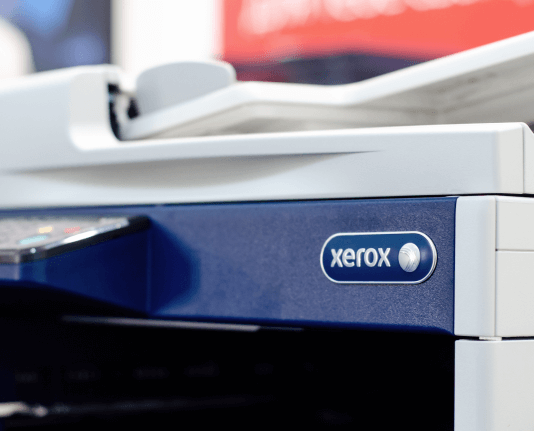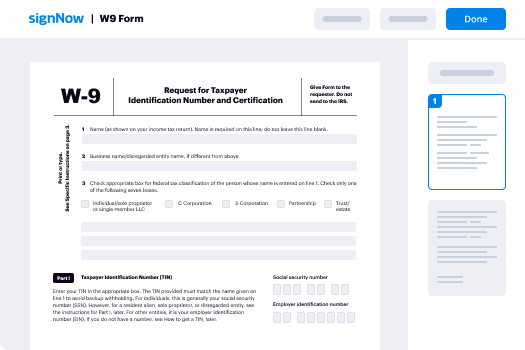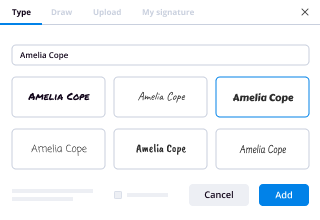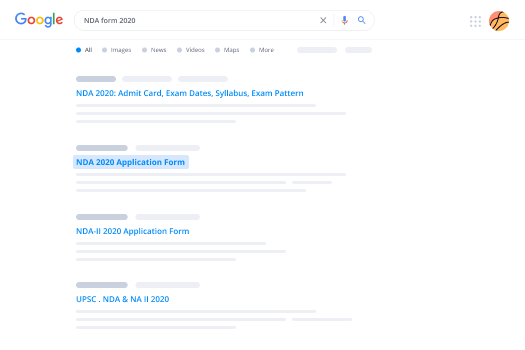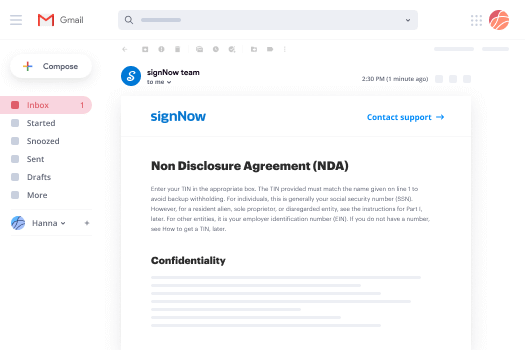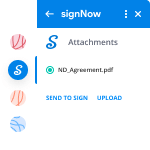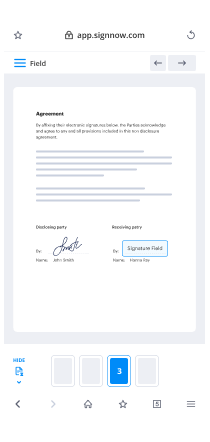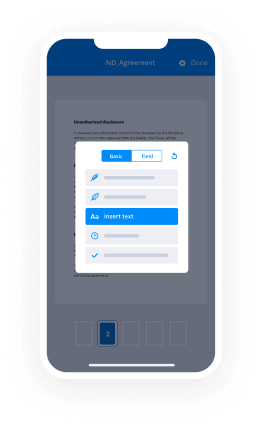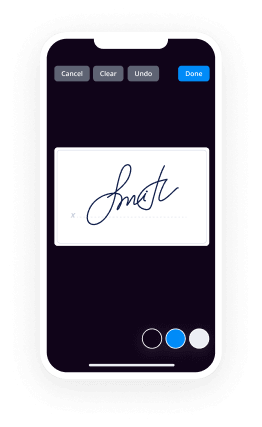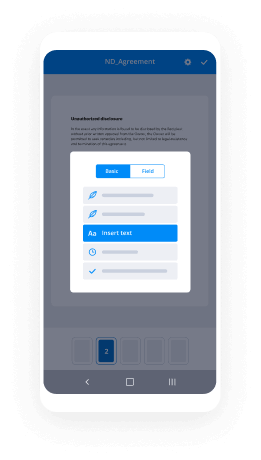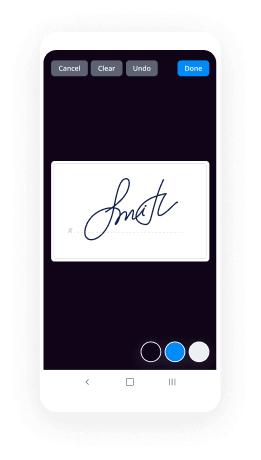How To Implement Sign in SalesForce
Contact Sales
Make the most out of your eSignature workflows with airSlate SignNow
Extensive suite of eSignature tools
Robust integration and API capabilities
Advanced security and compliance
Various collaboration tools
Enjoyable and stress-free signing experience
Extensive support
Keep your eSignature workflows on track
Our user reviews speak for themselves






Guide to Implementing Salesforce
Deploying Salesforce can optimize your business functions, boosting efficiency and communication. Utilizing tools such as airSlate SignNow, you can effortlessly oversee your documents and signatures, making the integration process more seamless and effective. This manual will guide you through the procedure of implementing Salesforce using airSlate SignNow for your document signing requirements.
Implementing Salesforce with airSlate SignNow
- Launch your web browser and go to the airSlate SignNow site.
- Set up a free trial account or sign in if you already possess one.
- Choose the document you want to sign or send for eSignature.
- If you intend to reuse this document, save it as a template for later use.
- Modify your document by incorporating fillable fields or any essential information.
- Add your signature and specify areas for your recipients' signatures.
- Click Continue to configure the eSignature invitation for distribution.
By adhering to these guidelines, you can successfully implement Salesforce while using airSlate SignNow for all your document signing necessities. This integration not only simplifies the procedure but also guarantees that your business runs more effectively.
Prepared to boost your workflow and simplify document management? Begin your free trial with airSlate SignNow today and see how effortless it is to eSign documents with an intuitive, budget-friendly solution that provides excellent ROI, clear pricing, and round-the-clock support.
How it works
Rate your experience
-
Best ROI. Our customers achieve an average 7x ROI within the first six months.
-
Scales with your use cases. From SMBs to mid-market, airSlate SignNow delivers results for businesses of all sizes.
-
Intuitive UI and API. Sign and send documents from your apps in minutes.
A smarter way to work: —how to industry sign banking integrate
FAQs
-
What is the first step in learning how to implement Salesforce with airSlate SignNow?
The first step in learning how to implement Salesforce with airSlate SignNow is to assess your business needs and document workflows. Understanding how your team will use Salesforce alongside SignNow will help you configure the integration effectively. This includes identifying the types of documents you frequently send for eSignatures.
-
How does airSlate SignNow help in the process of how to implement Salesforce?
airSlate SignNow simplifies the process of how to implement Salesforce by providing seamless integrations that connect your document workflows directly with Salesforce's CRM. This integration allows you to send, sign, and manage documents without leaving the Salesforce platform, enhancing efficiency and reducing errors.
-
What are the key features of airSlate SignNow that support how to implement Salesforce?
Key features of airSlate SignNow that support how to implement Salesforce include customizable templates, automated workflows, and real-time document tracking. These features enable users to create efficient processes tailored to their needs, making it easier to manage customer interactions and paperwork directly from Salesforce.
-
Is airSlate SignNow a cost-effective solution for businesses learning how to implement Salesforce?
Yes, airSlate SignNow is a cost-effective solution for businesses learning how to implement Salesforce. With flexible pricing plans and a variety of features designed to optimize document management, businesses can save time and resources while ensuring compliance and security in their document workflows.
-
Can I integrate airSlate SignNow with other tools while learning how to implement Salesforce?
Absolutely! While learning how to implement Salesforce, you can also integrate airSlate SignNow with other popular tools like Google Drive, Dropbox, and more. This flexibility allows you to enhance your document management processes and maintain a cohesive workflow across various platforms.
-
What are the benefits of using airSlate SignNow when figuring out how to implement Salesforce?
Using airSlate SignNow when figuring out how to implement Salesforce offers numerous benefits, such as improved efficiency, faster turnaround times for document signing, and enhanced collaboration among team members. These advantages can lead to increased productivity and better customer satisfaction.
-
Are there any tutorials available for how to implement Salesforce with airSlate SignNow?
Yes, airSlate SignNow provides a variety of tutorials and resources to guide you through how to implement Salesforce effectively. These resources include step-by-step guides, video walkthroughs, and customer support to ensure you have the assistance needed throughout the integration process.
-
As a beginner, how can I become Salesforce Developer?
Firstly I would like to welcome you in advance to the community of salesforce developers :)For beginners I would recommend studying Salesforce Administrator basics first. This helps in understanding the way CRM works and the most frequently used technical terms while using the platform.Learning administrator basics also help us to distinguish when one can use configuration as opposed to coding. Configuration changes save time and energy of the developer and are always the recommended way of achieving a requirement.Once you are comfortable with administrative tasks and how to achieve stuff using configurative changes, jump to apex coding.Apex Language is very similar to any OOPs language but is much simpler. So if you already know or have worked on OOPs concepts, learning Apex programming will be quicker.I would recommend you to start learning from the Salesforce Trailhead websiteTrailhead | The fun way to learn SalesforceThis is an interactive website and a fun way to learn Salesforce. Start with Admin Beginner and then continue with Developer Beginner.Also, being a certified Salesforce Admin/ Developer will open a lot of doors for you and I would highly recommend getting certified whenever you are ready.
-
Is it easy to implement Salesforce?
SFDC is so broad, I can safely say one could spend their entire career learning, modeling and signNowing themselves for various aspects of the platform. There's just basic SFDC (Salesforce.com) and then there are other areas; Service Cloud, Sales Cloud, Heroku, Data.com, etc.The best advice I would give before even attempting to do anything "real" is to do the following;1. Sign up for a developer account (it's free - forever)2. Go through the http://wiki.developerforce.com/p... - examples by examples. It's basically all there - The problem I find is that people with software developer experience try to "beat into submission" their current experience to the SFDC platform.That, IMHO why SFDC is seen as "hard to learn" - it's not that it's hard. it's just hard to mentally ditch your previous experience (or at least tweak the heck out of it).Some For-instances - *. The APEX language, even though it's "java-like" is simply not Java.*. The Visualforce language, although "HTML-like" is simply not HTML or javascript. Further, the architecture of how it works is completely different from how thing work in typical web server environments.*. SOQL/SOSL Data queries are not SQL. The typical scenario is, many companies that have big expensive development staffs that try to just "pick up" SFDC, run into huge problems. Usually involving large licensing fees (upwards of $65/month/user to $250/month) and some completely befuddled developers....And then in come the consultants - billing out at about $250/hour (and up)Soon companies can be hemorrhaging money. SFDC has a lot of advantages - multi-tenant architecture, guaranteed availability, mobile apps, APIs, great, friendly user interface, internationalization, JSON/RESTful interfaces, lots of extensibility, a great user community.... and lots more. BUT- Learning the SFDC platform is infrastructure programming, pure and simple, with a lot of "clicks-not-code" activity.I've found it hard to convince java programmers, for instance, that (s)he can implement a workflow and/or Validation rule to do what they need to do, rather than sling a bunch of lines of code into a trigger or anonymous APEX to have things done.To learn Salesforce, throw your java/SQL/HTML (well most of your HTML) experience away, and just make it through the workbooks in the link I provided above.... THEN - determine if it's for you.There are so many specific tricks to learning how to build a really robust SFDC implementation, that it can seem daunting at first.... however, it's absolutely amazing to me how many people simply have not gone through the workbooks.... It's usually my first question: "have your developers gone through the Force.com workbook?"
-
How can we implement salesforce-to-salesforce integration?
There is an easy and a hard answer to this question and the reason is that the question is missing some key information. Mainly, it is missing the why that could be used to find out more for the how.The easy answer is that Salesforce has tools built into that allow a transfer of the metadata from one org to the other. The metadata transfer is needed to ensure that all the objects and custom objects together with any new custom fields will be available in the new org. With transferring these in the form of change sets, you cannot guarantee that the data will load from one org to the other.The hard answer is probably in the fact that there is a reason for the question, which we do not know. One of the typical false reasons is the transfer to Lightning Experience from Classic. There is no reason why you should need to configure a new org. Sometimes, however, the org needs to be split as in companies splitting into to entities. A lot of prework needs to be spent on understanding the newco’s business process and how it should differ from the existing support in Salesforce.I know, not much information, but by expanding the question to give us insight into why the SF to SF transfer, would help me understand what you want to achieve.
-
How can Salesforce be implemented in a software provide company?
Easily, as long as your company developers aren’t developer happy. What I mean by this the fact that Salesforce was created out of the need for simplicity purposes. The primary audience and people that Salesforce Account Executives and Pre-Sales Engineers prefer to speak with are business users.Ideally the best way to implement Salesforce is to remain as close as you can to point-n-click development aka declarative programming. The less actual “development” you do the faster you can design, build and deploy. Especially if your software sales people want to leverage the system as fast as possible.Don’t get me wrong, I love developers for all that they are capable of doing when I need them but, I have seen and worked with teams who for what ever reason, could not remain simplified in their rationale and developed themselves “into a box.” Which eventually all needed to be undone to advance greater business needs down the road as they say. Declarative good, tech debt bad.
-
How do you implement Salesforce?
Well, Salesforce implementation is not a single step process and involves quite expert advice and guidance in order to make it appropriate for your business. Though there are online trainings present, which can help you but if you own an organization and want to implement Salesforce CRM for your business operations, then you can also hire a Salesforce implementation service provider. They can help you in app customization and implementation of Salesforce.It is always said that to get the best result of Salesforce CRM, its proper and appropriate implementation is must. So if you do want to get a result oriented successful Salesforce CRM implementation, then either implement it after getting complete training or hire an experienced and proficient Salesforce implementation service provider.If you hire any service provider, then make sure that they have enough experience of Salesforce implementation and have implemented it in any similar organization as well. You can also check the feedback of their service, before hiring any of them. Today there are plenty of Salesforce implementation service providers available, so choose any of them wisely and implement Salesforce CRM successfully. The consultants have the certified and experienced technical experts so can guide you during and after implementation.
-
How do I implement a loyalty program in Salesforce?
1) Reward 360-Degree Consumer BehaviorMost loyalty programs award purchases only, which is archaic. Loyalty should focus on customers’ 360-degree interaction. Think about your customers’ behaviors and award them for writing a review, connecting with you on Facebook, becoming an email subscriber, posting feedback or a question, etc.2) Give Thought to BrandingA good name can be a game changer when it comes to the popularity of your loyalty program. The name should be tied to your brand, for example: “Macy’s star rewards.” Keep it simple, descriptive and run it through a test group. Try to capture the emotion of your brand; for example, a value-oriented brand naming its loyalty program ‘Dealbucks.’3) Keep it SimpleHow you name your reward points can be a powerful motivator for your customers to collect more points. Keep the name descriptive so customers know exactly what they are earning. Engage your audience by understanding their demographics and the emotional connection they have with your brand.4) Make it Worth Their EffortCustomers won’t be willing to give you their personal information if you don’t make it worth their time and effort. Consider flexible redemption options including exclusive offers, special incentives, account credit, pre-sales, discount codes for stores and third party gift codes.5) How Much Should You Invest?Loyalty programs can increase repeat purchases by an average of 25%. Suppose your yearly revenue is $1 million; 40% of that revenue derives from repeat sales, as per the industry average. Implement a loyalty program, and you will receive 25% of this in incremental revenue. To boost your ROI by four times, you should be prepared to invest around $25,000 in your loyalty program. Alternatively, you should allocate 2.5% of your annual revenue to your loyalty marketing budget.6) Promote. Don’t Irritate.Your loyalty program should be aggressively promoted without being intrusive. Place a link to the program in the top and bottom navigation bars on your site. Display the points that can be earned next to the ‘add to cart’ button on the product pages. Embed a link to the loyalty program in your newsletter to encourage enrollment. As soon as users earn points on your site, notify them with a drop-down animation or send them an email notification to keep them incentivized.Now you have some of the knowledge you’ll need to design a successful loyalty program. Remember, its impact on sales is directly linked to how you recognize and reward every action of your customer. If they’re happy, they will be loyal.
-
How can we implement a billing feature in Salesforce?
A number of billing solutions out their integrate through Api with Salesforce so if I am understanding the question correctly its just about integrating those API and a developer with a good knowledge of Visualforce should be able to do it..
-
How much does it cost to implement Salesforce? I've heard "for every $1 you spend on licensing fees, you spend another $1 in imp
Salesforce's pricing (from $5/user/month) can make it seem like a 'cheap' CRM solution. But like most enterprise software, there is an additional cost for implementing it properly and in a way that creates the value you hope for.Remember that Salesforce implementation partners and contractors typically charge per hour. So the longer your implementation takes the more it will cost. Read on to learn about what drives the clock.But first, here's the simple, straight-forward answerThe $1 rule of thumb is false. A typical Salesforce implementation would cost more. Salesforce offers enterprise-grade software as a service. This rule of thumb misleads users into thinking that it is 'cheap' to use Salesforce.Now, the more complicated, honest answer (generalized)Salesforce implementation can require anywhere from $5,000 to well over $80,000. The investment a company makes in the implementation is a function of several factors. See below (in no particular order). The size of your organizationThis can measured by either the number of users, number of customers or number of transactions that you handle. Typically, bigger operations/organizations will require larger investments in the implementation of Salesforce.The industry your operate inAre you an online retailer? A day spa? A professional blogger? A membership-based not-for-profit organisation? Do you sell goods or services? Some industry or business have more complex sales pipelines than other. Some businesses require deeper customer engagement than other. Here complexity generally drives the clock. The type & complexity of your organization The more complex your organisation (corporate structure, hierarchy, internal procedures, business processes, etc) the more time your implementation team will need to implement Salesforce.Your business objectivesIf you are just looking to track customer in a cloud CRM then implementation will command a lower investment. But if you want to create a personalized customer experience or offer efficient customer service or build a positive customer-advocate community around your brand ... your implementation project will take much longer. There are many more factors that will affect your investment in Salesforce (an investment in your business, really). For example:If you are migrating from another CRMIf your data needs to be cleaned before it can be imported into SalesforceIf you must integrate Salesforce with other applications (e.g. accounting software)If you must integrate Salesforce with other business processesIf you want to implement different features of SalesforceIf you need to define a technology strategy (consulting costs)If you need advanced training (in addition to basic free training)You should also remember that implementation partners or contractors can charge anywhere from $16/hour to over $190/hour. The best way to get an answer to your question is to find a Salesforce implementation partner or contractor and ask them for an estimate. The 'better' teams will do this for free. Perhaps what you really want to know is: What Return On Investment (ROI) should I expect from my Salesforce licences?I hope this helped. If it did, give my answer a bump: Click Upvote !- Ranger Louis | Engineer at CRM Rangers
Trusted esignature solution— what our customers are saying
Get legally-binding signatures now!
Related searches to How To Implement Sign in SalesForce
Frequently asked questions
How do i add an electronic signature to a word document?
How do you know an electronic signature is real?
How to store electronic signature in database?
Get more for How To Implement Sign in SalesForce
Find out other How To Implement Sign in SalesForce
- Florida marriage license application pdf 41238467 form
- Pse form
- Faa form 8130 9
- 1st atlantic surety company form
- G a r 14 a see rule 66 i 90 i i form
- F table pdf form
- Format of approval letter from cyprus internapa college image
- Transaction cover sheet sale apre all pros real estate form
- Ta06 form
- Form tas 2 the chinese university of hong kong
- Iee checklist form
- 8879 k form
- Musc kidney transplant referral form
- Dse mobile app form
- The magicians council fifth grade reading comprehension worksheet autosaved doc form
- Woodshop safety worksheet form
- 116534 form
- Deviation form
- Bpsc teletalk bd form
- Intake forms system transition housing 288022

